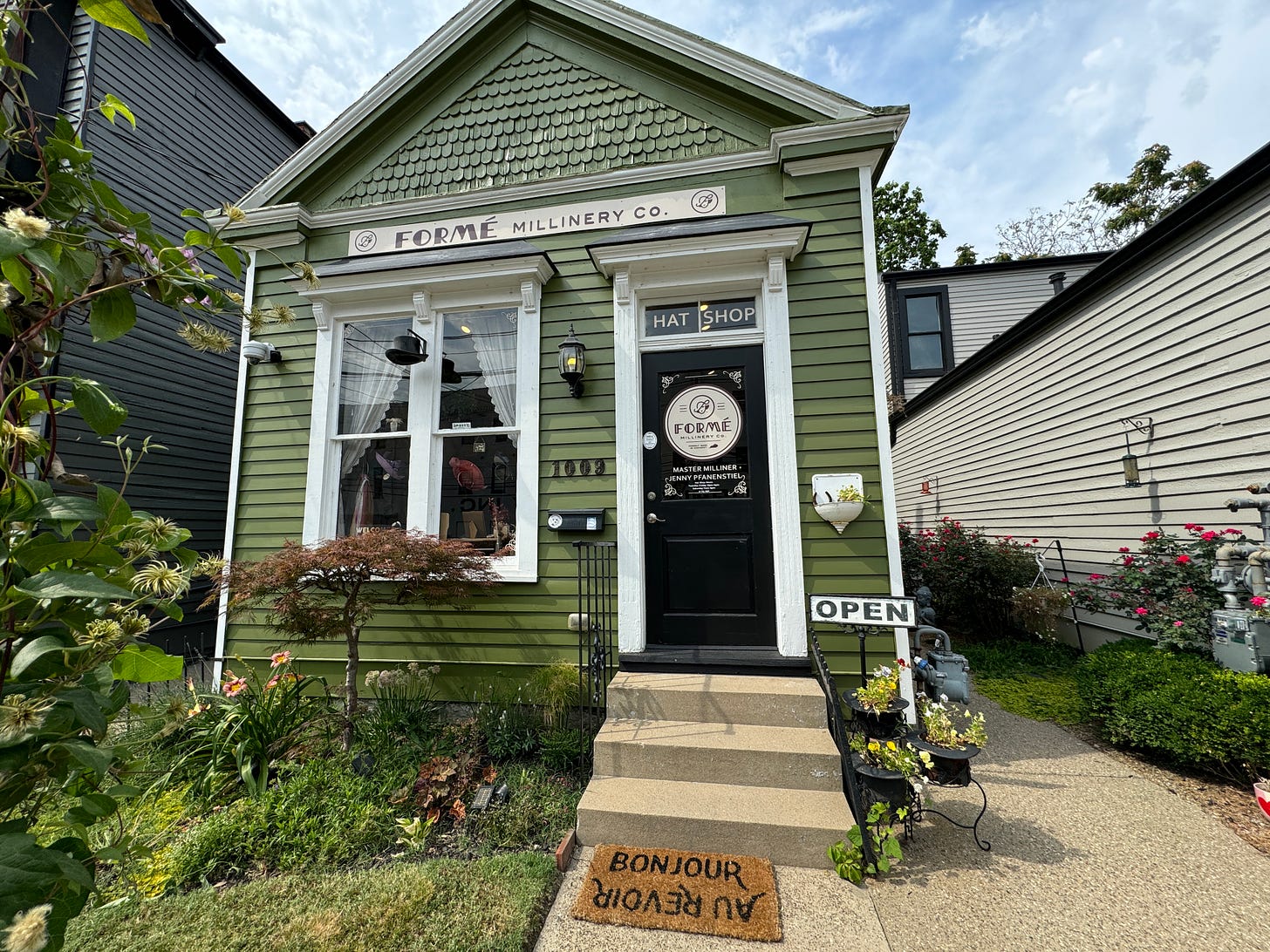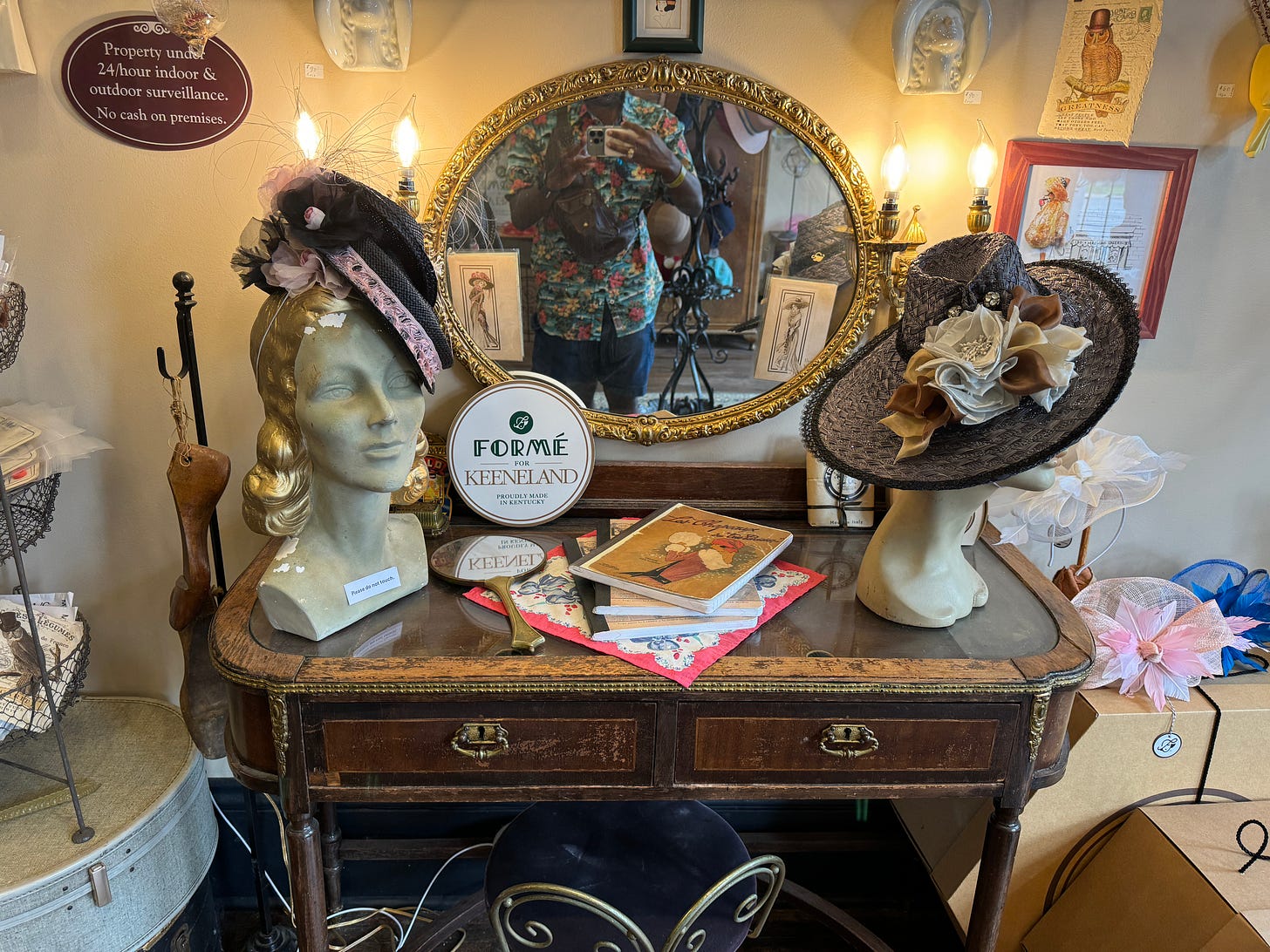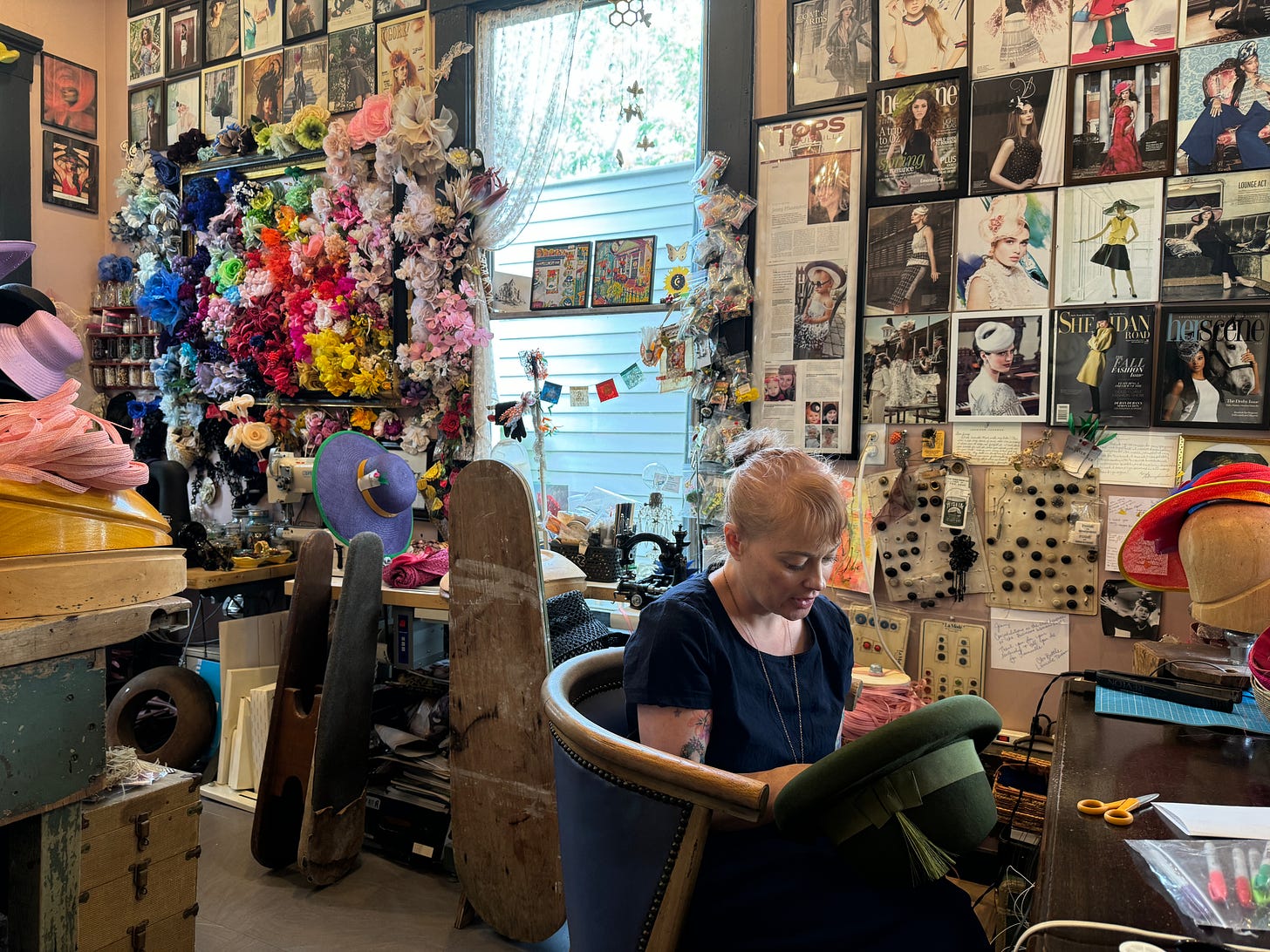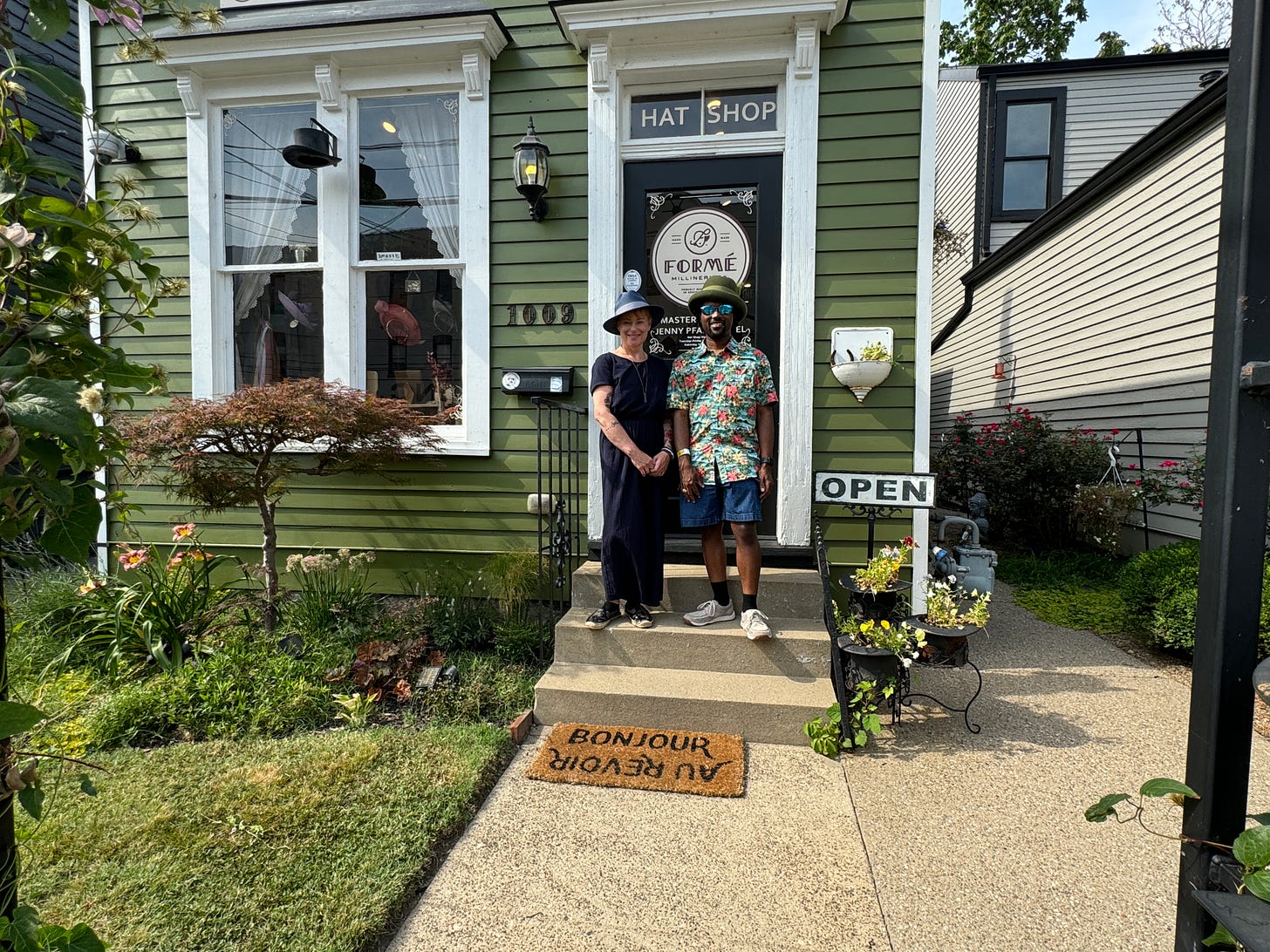: In this entry of Experts Across Realities, I had a chance to enjoy shopping and exploring on vacation in Louisville, Kentucky earlier this summer. Being in the city that hosts the Kentucky Derby (an event well-known for fancy hat wearing), I was on the lookout for nice hats. That of course means visiting Formé Millinery, home of Master Milliner Jenny Pfanenstiel, who is the official milliner for the Kentucky Derby Museum and featured milliner of the Kentucky Derby for the past five years. We had a chance to chat about millinery and how the agency and expression of hat-wearing can transfer across realities...
: How did you get started with a career in millinery?
Jenny Pfanenstiel: I started sewing when I was five years old. I grew up in a family where my mother, my grandmother, and my aunt made my clothes for my sister and I, and the toys and dolls that we played with. So I always had kind of a natural inkling to make things with my hands, and I ended up going to fashion design school at the Art Institute of Colorado in Denver. I thought I was going to make costumes forever, which I did make costumes for a number of years, but I'd always loved hats, and I ended up attending a seminar in Chicago. A woman was talking about the traditional techniques of hat making there. I'm an old soul, and she was talking about this 200-year-old technique of molding over the wood that really intrigued me. And when I looked more into it to try to learn these techniques themselves, there wasn't a lot offered in the U.S., so I ended up going to Australia and doing an apprenticeship. Since I knew how to hand sew, it came natural to me, a light bulb went off. That was 17 years ago.
I completely changed gears from there, and honestly I just started making hats as a hobby for fun in my basement in Chicago. Primarily making winter hats out of felt and wool, I did a show at the local merchandise mart. The woman next to me was from Louisville, Kentucky, and she would ask me if I'd ever considered making hats for the Derby. Ultimately that's what brought me here, and I fell in love with the town and the people, which really differed from a big city, and I was able to open my own store. Even though I didn't start in this location, I was about a mile away in a 200 square foot little studio, and eventually moved up to my own space. The way that I make hats, because I continue to make them the old traditional way, is one thing that I truly love to do, because many of the forms are vintage.
What has stayed the same and what's changed with millinery over your career?
There's only three hat block makers left in the world, so a lot of the hat blocks that I use are vintage. And so for me, working with the hat blocks and molding the material over them, I like to think about who made hats on these exact blocks hundreds of years ago, and who was it for, what collections was it for, how many times did it travel around the world, and for me it's almost like the energy of those people comes through in the making of each hat, and making it a part of history but also modern, because I'm a modern-day milliner.
I would say that not many people still make hats the traditional way. They're using a lot of new technology, which just stamps out the hat forms in like two seconds. They're big steam machines for particular shapes that just stamp down material and form it into a thing that takes you about three to four days to make one hat. That's probably the biggest change. I think with technology and just people wanting to do things quickly, it's more about quantity opposed to quality, whereas with me, I create my hats to almost be an heirloom to be passed down a generation. But I think that's why people seek me out too, because they appreciate handmade things that they know will last a long time, being unique and one-of-a-kind.
I feel like there's a hat for everyone. Whether you're wearing a hat that's mine or someone else's, the fact that you're wearing one is what matters to me.
Can you speak to how interdisciplinary the craft of millinery is?
Well I don't carve my own hat blocks1, but it certainly utilizes craftsmanship in many forms. Especially with the hat block makers, with there only being three left in the world who actually make them from carving by hand. It’s gratifying to know that it's still helping keep them in business, even just with what I do, even if the people that I work with on my team aren't blocking the material over the wood, I still utilize people with their hand stitching, which is something that a lot of people don't do either. They're doing it by machine or they're using glue, and so I like to help keep people even just techniques of hand sewing, which obviously dates back a long, long time ago as well. It's hard to find someone that can hand sew really well, but there are tailors and people like that here that have come from even other countries that have come over that are immigrants, and they sewed or did tailoring in their country, and so they come here and I find them, and then they get a job sewing.
So yeah, the hat block makers, stitchers, even the supplies that I get, these supplies you can't just buy at Jo-Anne Fabrics or Michael's. They're made in their native areas. For instance, this straw is native to the Philippines, and is all hand-woven straw. Somebody is weaving these. I even get straw from Ecuador. Even just with that, a lot of new generations actually aren't taking over those techniques. We hear a lot of times that the younger generation just isn't interested in learning how to weave, which is a shame. Some of it's being transferred to machines, but even just the raw materials are still made of very old traditional techniques as well.
What is your message to people in social VR about the hats that they put on their avatars?
When it comes to wearing hats, if you want to wear a hat in the virtual world, then by all means go ahead…I feel like there's a hat for everyone. Whether you're wearing a hat that's mine or someone else's, the fact that you're wearing one is what matters to me. because the more people who wear hats, the more people will appreciate them and will go, “Oh, that looks really nice on you. Maybe I should try to wear a hat! I've never really liked hats on myself, but maybe I should revisit that and see if I can find something that looks good on me!” So yeah, I'm definitely all for people wearing hats, regardless of what realm you're in.
You mentioned generations earlier. What's your message to younger generations about handmade creativity and time?
I think because I have learned to appreciate handmade things and being an old soul, I understand how the processes have changed over the centuries and years, so I've certainly learned to appreciate that. I would say a lot of the younger generation who maybe didn't grow up around that, they kind of want things that are quick, and right now, and I think especially if you've only been alive when the internet's been around, you've definitely grown up in an era where it's all very quick satisfaction and things like that. But for me, I almost like to almost reverse time and go back to where things were a little bit more simpler, because yeah, somebody could probably at some point in my life be able to click two fingers and poof, this exists.
So for me, I want to try to hold onto those old traditions and the old craftsmanship. I think you'll never be able to replace truly handmade work. You might be able to duplicate quality at some point, however, it's also the person, their energy, their time, and their passion that also all goes into the making of a hat. It's not just about the movements of making a hat. It's about the feeling that that person has. I always talk about with my employees, “Happy people, Happy employees, Happy hats”, because if you want to be happy, you want to love what you do, and I feel like that will transition into the hat. It’s the same reason why I like to utilize the old hat blocks, since I feel like it's paying homage to the people who made that hat block. The people who made hats on those hat blocks way before my time are who I'm also thanking and being grateful for what they did prior to me.









